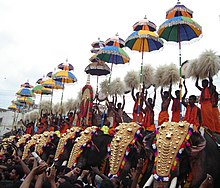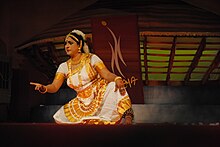Kerala (/ˈkɛrələ/), historically known as Keralam, is a state in South India on the Malabar coast. It was formed on 1 November 1956 following the States Reorganisation Act by combining Malayalam-speaking regions. Spread over 38,863 km2 (15,005 sq mi), it is bordered by Karnataka to the north and northeast, Tamil Nadu to the east and south, and the Lakshadweep Sea to the west. With 33,387,677 inhabitants as per the 2011 Census, Kerala is the thirteenth largest state by population and is divided into 14districts with the capital being Thiruvananthapuram. Malayalam is the most widely spoken and the official language of the state.
Kerala has the lowest positive population growth rate in India; 3.44%, highest Human Development Index (HDI); 0.790 in 2011, the highest literacy rate; 93.91% in the 2011 census, the highest life expectancy; 77 years and the highest sex ratio; 1,084 women per 1000 men. The state has witnessed significant emigration, especially to the Gulf states during the Gulf Boom of the 1970s and early 1980s, and its economy depends significantly on remittances from a large Malayali expatriate community. Hinduism is practised by more than half of the population, followed by Islam and Christianity. The culture is a synthesis of Aryan and Dravidiancultures, developed over millennia, under influences from other parts of India and abroad.
The production of pepper and natural rubber contributes significantly to the total national output. In the agricultural sector,coconut, tea, coffee, cashew and spices are important. The state's coastline extends for 595 kilometres (370 mi), and around 1.1 million people in the state are dependent on the fishery industry which contributes 3% to the state's income. The state has thehighest media exposure in India with newspapers publishing in nine languages; mainly English and Malayalam. Kerala is one of the prominent tourist destinations of India, with backwaters, beaches, Ayurvedic tourism and tropical greenery as its major attractions.
Agriculture
The major change in agriculture in Kerala occurred in the 1970s when production of rice fell due to increased availability of rice all over India and decreased availability of labour.[200] Consequently, investment in rice production decreased and a major portion of the land shifted to the cultivation of perennial tree crops and seasonal crops.[201][202] Profitability of crops fell due to a shortage of farm labour, the high price of land, and the uneconomic size of operational holdings.[203]
Kerala produces 97% of the national output of black pepper[204] and accounts for 85% of the natural rubber in the country.[205][206]Coconut, tea, coffee, cashew, and spices—including cardamom, vanilla, cinnamon, and nutmeg are the main agricultural products.[207][208][209][210][211][212] The country is earning more than ₹4000 crores annually through the export of processed cashews, prepared from Kollam alone.[citation needed] The key agricultural staple is rice, with varieties grown in extensive paddy fields.[213] Home gardens made up a significant portion of the agricultural sector.[214] Related animal husbandry is touted by proponents as a means of alleviating rural poverty and unemployment among women, the marginalised, and the landless.[215][216] The state government promotes these activities via educational campaigns and the development of new cattle breeds such as the Sunandini.[217][218]
Though the contribution of agricultural sector to the state economy was on the decline in 2012–13, through the strength of the allied livestock sector, it has picked up from 7.03% (2011–12) to 7.2%. In the 2013–14 fiscal period, the contribution has been estimated at a high of 7.75%. The total growth of the farm sector has recorded a 4.39% increase in 2012–13, over a paltry 1.3% growth in the previous fiscal year. The agricultural sector has a share of 9.34% in the sectoral distribution of Gross State Domestic Product at Constant Price, while the secondary and tertiary sectors has contributed 23.94% and 66.72% respectively.[219]
There is a preference for organic products and home farming compared to synthetic fertilizers and pesticides.[220][221] Entekrishi.com is Kerala's first online open market for consumers/farmers to connect directly with each other. It provides a platform or rather a virtualmarket for farmers and end consumers where the farmers can display their crops, mention the quantity, specify the method of cultivation, expected price for the commodity and contact details. Farmers can post their products in any quantity ranging from 1 kilogram (2.2 lb) to 1,000 kilograms (2,200 lb) which means even a person having a kitchen farm may find a buyer.[222]
Culture
The culture of Kerala is composite and cosmopolitan in nature and it is an integral part of Indian culture.[6] It is synthesis of Aryan andDravidian cultures,[351] defined by its antiquity and the organic continuity sustained by the Malayali people.[352] It has been elaborated through centuries of contact with neighbouring and overseas cultures.[353] However, the geographical insularity of Kerala from the rest of the country has resulted in the development of a distinctive lifestyle, art, architecture, language, literature and social institutions.[6] Over 10,000 festivals are celebrated in the state every year.[354] The Malayalam calendar, a solar calendar started from 825 CE in Kerala,[355]finds common usage in planning agricultural and religious activities.[356]
Festivals[
Many of the temples in Kerala hold festivals on specific days of the year.[357] A common characteristic of these festivals is the hoisting of a holy flag which is brought down on the final day of the festival after immersing the deity.[358] Some festivals include Poorams, the best known of these being the Thrissur Pooram.[359] "Elephants, firework displays and huge crowds" are the major attractions of Thrissur Pooram.[360] Other known festivals are Makaravilakku,[361] Nenmara Vallangi Vela[362] and Utsavam.[363] Temples that can afford it will usually involve at least one richly caparisoned elephant as part of the festivities. The idol in the temple is taken out on a procession around the countryside atop this elephant. When the procession visits homes around the temple, people will usually present rice, coconuts, and other offerings to it.[364] Processions often include traditional music such as Panchari melam or Panchavadyam.[365]
Onam
Onam is a harvest festival celebrated by the people of Kerala and is a reminiscent of the state's agrarian past.[366][367] It is also the State festival of Kerala[368] with public holidays for four days from Onam Eve (Uthradom) to the fourth Onam Day.[369] Onam falls in the Malayalam month of Chingam (August–September)[370] and marks the commemoration of the Vamana avatara of Vishnu and the subsequent homecoming of King Mahabali.[371] It is one of the festivals celebrated with cultural elements such as Vallam Kali,[372]Pulikali,[373] Pookkalam,[374] Thumbi Thullal[375] and Onavillu.[376]
Cinema
Malayalam films carved a niche for themselves in the Indian film industry with the presentation of social themes.[386][387] Directors from Kerala, like Adoor Gopalakrishnan, John Abraham, P. Padmarajan, G. Aravindan and Shaji N Karun have made a considerable contribution to the Indian parallel cinema. Kerala has also given birth to numerous actors, such as Satyan, Prem Nazir, Jayan, Adoor Bhasi, Bharath Gopi, Mammootty, Mohanlal, Suresh Gopi, Sreenivasan, Jayaram, Murali, Dileep, Oduvil Unnikrishnan, Thilakan, Jagathy Sreekumar, Nedumudi Venu, KPAC Lalitha. Late Malayalam actor Prem Nazir holds the world record for having acted as the protagonist of over 720 movies.[388] Since the 1980s, actors Mammootty and Mohanlal have dominated the movie industry; Mammootty has won three National Awards for best actor while Mohanlal has two to his credit.[389] Malayalam Cinema has produced a few more notable personalities such as K.J. Yesudas,[390] K.S. Chitra,[391] Vayalar Rama Varma, M.T. Vasudevan Nair and O.N.V. Kurup,[392] the last two mentioned being recipients of Jnanpith award, the highest literary award in India.[393]
Literature
Malayalam literature starts from the late medieval period and includes such notable writers as the 14th-century Niranam poets (Madhava Panikkar, Sankara Panikkar and Rama Panikkar),[394][395] and the 17th-century poet Thunchaththu Ezhuthachan, whose works mark the dawn of both the modern Malayalam language and its poetry.[396] Paremmakkal Thoma Kathanar and Kerala Varma Valiakoi Thampuranare noted for their contribution to Malayalam prose.[397][398][399] The "triumvirate of poets" (Kavithrayam): Kumaran Asan, Vallathol Narayana Menon, and Ulloor S. Parameswara Iyer, are recognised for moving Keralite poetry away from archaic sophistry and metaphysics, and towards a more lyrical mode.[400][401][402] In the second half of the 20th century, Jnanpith winning poets and writers likeG. Sankara Kurup, S. K. Pottekkatt, Thakazhi Sivasankara Pillai, M. T. Vasudevan Nair and O. N. V. Kurup had made valuable contributions to the modern Malayalam literature.[403][404][405][406][407] Later, writers like O. V. Vijayan, Kamaladas, M. Mukundan, Arundhati Roy, Vaikom Muhammed Basheer, have gained international recognition.[408][409][410][411]
Cuisine
Kerala cuisine has a multitude of both vegetarian and non-vegetarian dishes prepared using fish, poultry, and meat. Culinary spices have been cultivated in Kerala for millennia and they are characteristic of its cuisine.[412] Rice is a dominant staple that is eaten at all times of day.[413] A majority of the breakfast foods in Kerala are made out of rice, in one form or the other (idli, puttu, appam, or idiyappam), tapioca preparations, or pulse-based vada.[414] These may be accompanied by chutney, kadala, payasam, payar pappadam,appam, chicken curry, beef fry, egg masala and fish curry.[208] Lunch dishes include rice and curry along with rasam, pulisherry and sambar.[415] Sadhya is a vegetarian meal, which is served on a banana leaf and followed with a cup of payasam.[416] Popular snacks include banana chips, yam crisps, tapioca chips, unniyappam andkuzhalappam.[417][418][419] Seafood specialties include karimeen, prawns, shrimp and other crustacean dishes.[420]
Elephants
Elephants have been an integral part of the culture of the state. Kerala is home to the largest domesticated population of elephants in India—about 700 Indian elephants, owned by temples as well as individuals.[421] These elephants are mainly employed for the processions and displays associated with festivals celebrated all around the state. More than 10,000 festivals are celebrated in the state annually and some animal lovers have sometimes raised concerns regarding the overwork of domesticated elephants during them.[354]In Malayalam literature, elephants are referred to as the 'sons of the sahya.[422] The elephant is the state animal of Kerala and is featured on the emblem of the Government of Kerala.[135]









